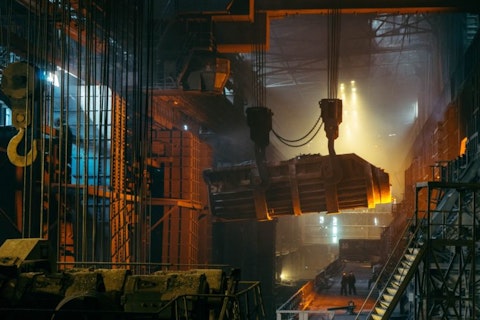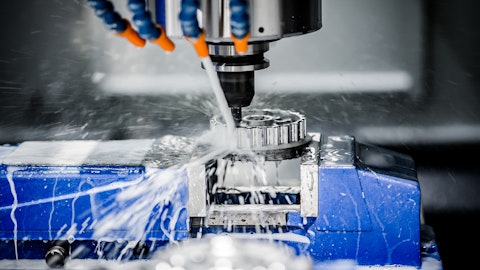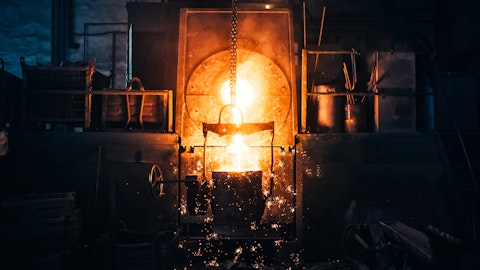Algoma Steel Group Inc. (NASDAQ:ASTL) Q1 2024 Earnings Call Transcript August 12, 2023
Operator: Hello, and welcome to today’s conference call to discuss Algoma Steel’s Fiscal First Quarter 2024 Financial Results. My name is Doug and I’ll be your operator for today’s call. At this time, I’d like to hand the call over to Mike Moraca, Treasurer and Investor Relations Officer for Algoma. Mr. Moraca, please go ahead.
Mike Moraca: Good morning, everyone, and welcome to Algoma Steel Group Inc’s first quarter fiscal 2024 earnings conference call. Leading today’s call are Michael Garcia, our Chief Executive Officer; and Rajat Marwah, our Chief Financial Officer. As a reminder, this call is being recorded and will be made available for replay later today in the Investors section of Algoma Steel’s corporate website at www.algoma.com. I would like to remind you that comments made on today’s call may contain forward-looking statements within the meaning of applicable securities laws, which involve assumptions and inherent risks and uncertainties. Actual results may differ materially from statements made today. In addition, our financial statements are prepared in accordance with IFRS, which differs from U.S.GAAP and our discussion today includes references to certain non-IFRS financial measures.
Last evening, we posted an earnings presentation to accompany today’s prepared remarks. The slides for today’s call can be found in the Investors section of our corporate website. With that in mind, I would ask everyone on today’s call to read the legal disclaimers on Slide 2 of the accompanying earnings presentation and also refer to the risks and assumptions outlined in Algoma Steel’s First Quarter Fiscal 2024 Management’s Discussion and Analysis. Please note that our financial statements are prepared using the U.S. dollar as our functional currency, and the Canadian dollar as our presentation currency. Our fiscal year runs from April 1 to March 31 and our financial statements have been prepared for the three months ended June 30, 2023. Please note all amounts referred to on today’s call are in Canadian dollars unless otherwise noted.
Following our prepared remarks, we will conduct a question-and-answer session. I will now turn the call over to our Chief Executive Officer, Michael Garcia.
Michael Garcia: Thank you, Mike. Good morning and thank you for joining us to discuss our fiscal first quarter results. As always, I will begin my remarks by addressing what truly matters most to us. The safety and well-being of everyone at Algoma Steel. During our last quarterly call, we updated you on the tragic fatality of a contract worker at Algoma Steel on June 15, the Ministry of Labor was notified and attended the site to conduct its investigation, which remains ongoing. At Algoma, we believe in safety without compromise, and while our continued dedication has led to a significant improvement in our lost-time injury frequency rate over the past decade, we remain committed to creating a safe zero-injury workplace. Next, I’ll cover the key events and milestones during our fiscal first quarter, and subsequent to its end, as well as an update on the progress at our EAF project.
I will then turn the call over to Rajat for a deeper dive into the numbers and a discussion of our strong liquidity and balance sheet, before closing with an update on market conditions. Our results for fiscal first quarter of 2024 came in modestly ahead of our previously disclosed guidance for both shipments and adjusted EBITDA. Our shipments of 569,000 tons were up 5.9%, versus the prior year period. Our results reflect a quarter of solid operational execution, even in the face of commodity price volatility and we expect that momentum to continue throughout the fiscal year as we work in parallel to advance the investment and activity at our EAF project. On our last call, we provided an update on the progress of Phase 2 of our plate mill modernization project, including the in-line shear installation, which is progressing ahead of schedule.

Photo by ant rozetsky on Unsplash
I am pleased to report that the shear installation is now complete and we expect to begin cold commissioning this month with hot trials expected by the end of this quarter. We plan for higher plate production levels after commissioning. We are very excited about this given the continued robustness of our current plate market and the high price spread over hot-rolled coil. This higher production level will allow us to capitalize on this market opportunity and to build inventory, ahead of the planned Phase 2 hot mill outage to upgrade the hot mill drives, currently scheduled for April of 2024. Next, I’d like to update you on our progress during the quarter on our transformational EAF project. This will ultimately increase our throughput capacity by roughly one-third, from 2.8 million tons per year of liquid steel-making capacity today via the blast furnace route to 3.7 million tons, employing dual electric arc furnaces upon completion.
The higher liquid steel output is expected to match our expanded downstream finishing capacity, as we increase production at our plate mill. Importantly, this will improve overall product mix, while simultaneously lowering our carbon emissions by approximately 70% when fully operational. During the quarter, EAF expenditures totaled CAD74 million bringing cumulative spend as of June 30 to CAD341 million or 40% of our expected total project cost at the midpoint of our unchanged project budget. The construction of the main steelmaking building is progressing on schedule and we expect to begin receiving key equipment from Danieli this quarter. We continue to make meaningful progress securing the remaining portion of expected project cost, as bid packages continue to come in.
Our expectations to begin commissioning in late calendar 2024 are also unchanged. Our start-up plan continues to include normal production from our existing steel-making facility, while ramping up steel production from our EAF in calendar 2025, followed by a complete switch to EAF production. We said on the last call, and I would like to reiterate today, that we expect the completion of the EAF project will be funded through a number of existing capital resources, including cash on hand, cash generated through operations, a drawdown of excess working capital, and the capital resources already available to us, such as the Federal, SIF loans. Rajat will get into more details there, but given our strong balance sheet that includes no debt outside of government loans and with full availability under our ABL credit facility, our operations are well supported throughout this exciting transition.
Through the quarter, we demonstrated consistent and reliable operations. There is also no shortage of excitement here on site in Sault Ste Marie, as we see the EAF progressing rapidly and the future of our company becoming a reality. I’d like to once again thank all of our employees, whose execution continues to deliver solid operational and financial results, safely while simultaneously driving the EAF project forward. Now, I will pass the call over to Rajat to go over our financial results for the quarter and give more details on the expected funding of our capital expenditures.
Rajat Marwah: Thanks, Mike. Good morning and thank you all for joining the call. I’ll remind you again that all numbers are expressed in Canadian dollars unless otherwise noted. As Mike said, we had a solid quarter to start the fiscal year. Our first quarter results included adjusted EBITDA of CAD191.2 million or CAD336 per ton, which reflected an adjusted EBITDA margin of 23.1%. Cash generated from operating activity was CAD163.9 million, we finished the quarter with CAD300.6 million of unrestricted cash and our USD300 million revolving credit facility remains undrawn, representing total liquidity in excess of CAD600 million. As a reminder, the only remaining long-term debt on our balance sheet is in the form of government loans linked to our capital projects and those loans have highly attractive terms that include the potential for partial forgiveness of principal, as we reach certain carbon emission reduction targets with the shift to EAF steel-making in the coming years.
I will now dive into the key drivers of our performance in the quarter. We shipped 569,000 tons in the quarter, up 5.9% as compared to the prior year period. Our plate and strip production continues to run well, and despite normal seasonal maintenance in the second half of the year, including our annual vessel reline, we expect our shipment in each of the next two quarters to be roughly in-line with our typical run rate achieved over the last several quarters. Net sales realization averaged CAD1,323 per ton, down 18.9% versus the prior year period. The decrease versus the prior-year level, primarily reflects overall softer market conditions. Plate ricing continued to enjoy a significant premium relative to hot-rolled coil during the quarter, driven by resilient demand particularly from spending on infrastructure projects and durable goods.
As a reminder, we are the only discrete plate mill in Canada and we look forward to the incremental, additional tons from the plate mill in the second half of calendar 2023, as a result of the new shear installation Mike talked about. Steel revenue in the quarter totaled CAD754.5 million, down 14% versus the same quarter of last year, reflecting the lower average realizations per ton of steel that more than offset the increase in shipments. On the cost side Algoma’s cost per ton of steel products sold, averaged CAD950 in the quarter, up 3.3% versus the prior year period. The main drivers of the modest increase versus the prior year period include the cost of replacing internally produced coke with purchased coke, and higher cost of other key inputs, which more than offset the positive impact of the increase in volumes.
Cash flow from operations totaled CAD163.9 million for the quarter compared to CAD276.6 million in the prior year period, but up by CAD68.5 million sequentially. Our inventories at quarter end were CAD759.3 million, up only 5.1% during the quarter, which would otherwise have been a large increase due to normal seasonal build patterns of what is typically our lowest level in March. We expect to continue releasing inventories throughout the year, as quantities normalize with consistent production. Now, I would like to provide additional color on our funding plans for the EAF project. As previously noted, our outlook for total cost of the project remains in a range of CAD825 million to CAD875 million. Through the end of the quarter, we had spent CAD341 million, leaving approximately CAD510 million of investments, remaining to reach the mid-point of our project budget.
We are well positioned today when you look at our expected resources for those expenditure over the next 12 to 18 months. We have cash on hand of roughly CAD300 million and another CAD135 million of available capacity on our SIF loan and approximately CAD150 million of cash to be generated from drawing down excess working capital. Combined, this exceeds the expected capital requirement to complete the project and does not include any borrowings on our ABL or any contribution from operating cash flow. Highlighting the strong position we are in as we advance this transformative project. I would now like to turn the call back to Mike Garcia for closing comments.
Michael Garcia: Thank you, Rajat. Looking at the state of the North American steel market, pricing levels in the fiscal first quarter saw periods of volatility with index pricing for U.S. Midwest hot-rolled coil ranging from approximately CAD850 to CAD1,200 per ton. Subsequent to the quarter end prices have continued to decline to current levels in the low CAD800s. Plate pricing continues to demonstrate a significant premium as overall demand for plate products remains high, which in turn continues to benefit our average price realizations. While the steel business involves inherent volatility, we address that volatility by serving a diverse customer base that provides selling opportunities across Canada and the US. We traditionally service roughly 150 customers in a calendar year and target a high percentage of contract sales.
Those contracted volume commitments continued to provide stability to our order book and operations. And the lagging price mechanics help to smooth some of the volatility experienced when prices shift up or down quickly. While the forward curve show some expectation of stability at prices modestly lower than current spot, we’ve seen time again how quickly things can change. Regardless of the swings in our end markets, we will relentlessly maintain our primary focus of delivering prudent financial discipline and operational excellence. This will ensure our ability to execute our EAF project, ushering in the next phase of our company that defines the future of Algoma, provides the foundation for long-term value creation for our stakeholders and solidifies our leadership position at the forefront of green steel production in North America.
Thank you very much for your continued interest in Algoma Steel. We are off to a solid start of our fiscal year and look forward to the rest of what promises to be a transformational year. At this point, we’d be happy to take your questions. Operator, please give the instructions for the Q&A session.
See also 10 Best Warehouse and Self-Storage Stocks To Buy and 10 Best Inexpensive Stocks To Buy Right Now.
Q&A Session
Follow Algoma Steel Group Inc. (NASDAQ:ASTL)
Follow Algoma Steel Group Inc. (NASDAQ:ASTL)
Operator: [Operator Instructions] Our first question comes from the line of Katja Jancic with BMO Capital Markets. Please proceed with your question.
Katja Jancic: Hi. Thank you for taking my questions. Maybe just as a clarification, did you say that the volumes or shipments are expected to be similar in the next few quarters to the first quarter?
Rajat Marwah: Yes, so it’s – it’ll be similar, not exactly to the first quarter, but if you look at the last several quarters, it’ll be an average of that, so similar but not same.
Katja Jancic: And what about with plate expected to increase, is that still the expectation to raise volumes?
Michael Garcia: Yes, Katja this is Mike. So shear is in and where we are currently conducting cold commissioning followed by hot commissioning. So by the end of this calendar year, we should start to see a 10% to 15% increase in plate volume. Now, that assuming we’ve done the work on the commercial side and we have the orders, and so some of that will be reflected in plate shipments, some of it will be used to build inventory ahead of the outage next April. But the total increase will be in the 10% to 15% by this November-December timeframe.
Katja Jancic: Is this a bit of delay, I thought that was expected by third quarter calendar year?
Michael Garcia: No, I think it’s consistent with what we spoke about in our last call. Rajat?
Rajat Marwah: Yes, it was third fiscal quarter what we mentioned.
Katja Jancic: Okay. And then maybe just on the cost side, how should we think about cost in the next few quarters?
Rajat Marwah: So cost will be pretty similar to what we are seeing right now. There should be some reductions coming as we keep increasing our production on the coke batteries, our internal coke and start replacing it with purchased coke, but that probably will come towards the end of the fiscal year. But for the next, let’s say, one or two quarters our cost should be pretty similar.
Katja Jancic: Okay. Thank you so much.
Michael Garcia: Thank you.
Operator: Our next question comes from the line of David Ocampo with Cormark Securities. Please proceed with your question.
David Ocampo: Thanks. I just wanted to follow-up on the last line of questions regarding costs. I think – I seem to remember that a portion of it is tied to HRC prices or some sort of index type of steel, as well as the IODEX for iron ore. I just would have thought that would – with steel prices coming down at least in the next quarter or maybe next two quarters, but your input costs would also follow that. So, maybe you could help reframe how we should be thinking about cost in the following steel price environment?
Rajat Marwah: Sure. So you’re right, there is a portion of our contract that is linked to pricing and it has certain bands. So within a price range it moves and then it stops. So – and the other portion is based on IODEX. So with this – with the price drop in IODEX, remaining same or increasing it, it more or less offsets each other for the quarter or for the coming period. So that’s how iron ore will play. Scrap definitely will help because scrap is coming down, and we expect other commodities – commodity price, if they come down, if price remains at lower level in the following quarters, we should see some reduction coming, some slight reduction coming. But it totally depends on how the commodities plays out in the next couple of quarters.
But it should change slightly, but that’s why I said it’s very similar. Our cost quarter-over-quarter and for the next one or two quarters and then we will see some reductions coming just because of coke, as well as coal negotiations that will happen and it will start impacting in the next year. Does that give you some color.




